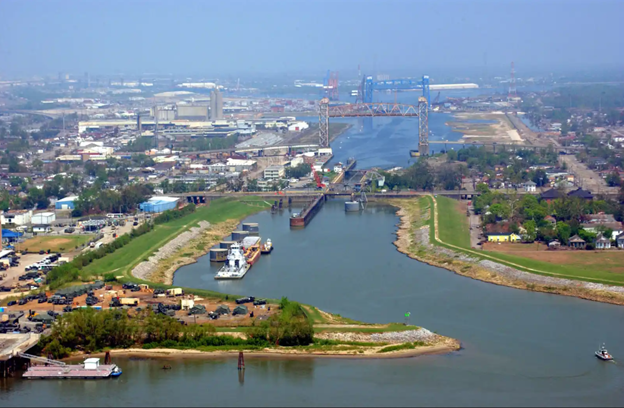The New Orleans Engineer District has published its draft supplemental general reevaluation report (GRR) and integrated supplemental environmental impact statement (EIS) for the replacement of the Inner Harbor Navigation Canal (IHNC) Lock, which opened to navigation in 1923.
The Corps of Engineers is proposing to replace the 102-year-old lock, which measures 640 feet by 75 feet with a 31.5-foot depth, with a shallow-draft chamber measuring 900 feet by 110 feet with a depth of 22 feet.
The current cost estimate for the project, which will also include the replacement of the St. Claude Avenue bridge that spans the canal, is about $4.68 billion, cost shared between the federal treasury and the Inland Waterways Trust Fund. At that price, about $3.51 billion would come from the general treasury, and about $1.17 billion would come from the trust fund.
According to the draft report, the New Orleans District anticipates that, if the Corps’ Chief of Engineers approves the recommended plan, engineering and design for the project could begin in fiscal year 2029, with construction going from 2033 to 2047, “assuming adequate future funding levels.”
The proposed design for the replacement lock has come a long way since the project was first conditionally authorized in 1956. For decades, the Port of New Orleans and local maritime interests supported a deep-draft lock to accommodate smaller ships that would use the Mississippi River-Gulf Outlet (MRGO), a short cut channel that connected the Gulf to the Inner Harbor Navigation Canal. The MRGO was authorized in 1956—the same year the IHNC lock replacement was authorized—and construction wrapped up in the mid-1960s.
The MRGO, though, never lived up to commercial expectations. What’s more, erosion along the banks of the MRGO led to dramatic widening of the canal over the years, such that the MRGO was blamed for much of the flooding in St. Bernard Parish from Hurricane Katrina in 2005. Just two years after the storm, the Corps of Engineers announced plans to close the canal to navigation. The Corps completed construction of a rock berm across the MRGO near Hopedale, La., in 2009.
With the closure of the MRGO in the late 2000s, the Corps pivoted from recommending a deep-draft lock at IHNC. The new 900-foot by 110-foot lock, with a lock floor elevation of -22 feet, is designed with the existing lock’s primary traffic in mind: towboats and barges.
“The recommended replacement lock can accommodate a six-pack of 195-foot by 35-foot barges with a towboat,” said Matt Roe, public affairs specialist for the New Orleans District.
The new lock, as proposed, would be built north of the existing Claiborne Avenue bridge, and while the new lock chamber will be bigger than the current one, the overall footprint of the Inner Harbor Navigation Canal will remain the same.
Changing needs at the lock aren’t the only reason for the decades-long delay in building a replacement. The project itself has garnered enormous opposition over the years from the surrounding communities. From the 1960s through the 1990s, the Corps studied the possibility of a new lock going through Violet, La., in St. Bernard Parish. However, local opposition and projected environmental impacts shifted focus to the existing Inner Harbor Navigation Canal. The recommended plan in a 1997 evaluation report called for a deep-draft lock near the existing lock. A 2003 lawsuit by the Holy Cross Neighborhood Association, the Gulf Restoration Network and the Louisiana Environmental Action Network challenged the 1997 record of decision, and a 2006 injunction in the wake of Hurricane Katrina put the project on hold until the New Orleans District conducted a supplemental EIS. Another supplemental EIS followed in 2009, but subsequent lawsuits led to another injunction against the Corps in 2011.
As the only connection between the east and west reaches of the Gulf Intracoastal Waterway on the east bank of the Mississippi River, and with its size requiring tows to trip through the lock, the Inner Harbor Navigation Canal Lock consistently ranks among the busiest in the country. Still, the Corps identified a benefit to cost ratio for the lock replacement of only 1.03.
The New Orleans District will accept comments on the project through July 17. The district plans to hold a public meeting to discuss the project on June 28 from 9 a.m. to 5 p.m. at the Andrew P. Sanchez & Copelin-Byrd Multi-Service Center, located at 1616 Fats Domino Ave in New Orleans. The most recent draft report, along with all previous documents on the project, is available at mvn.usace.army.mil by searching for “IHNC Lock Replacement.”
Featured image caption: An aerial image of the Inner Harbor Navigation Canal Lock in New Orleans. (Photo courtesy of the New Orleans Engineer District)



